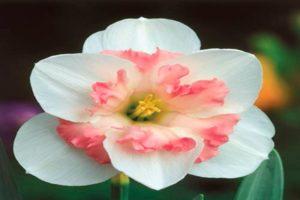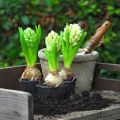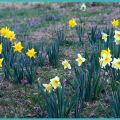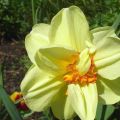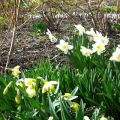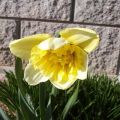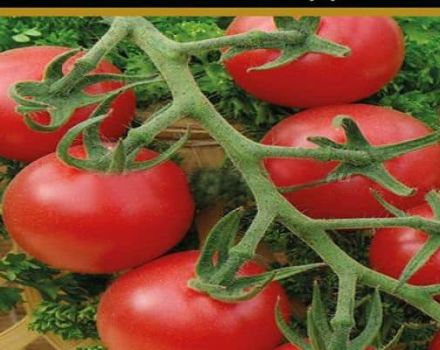Description and features of the narcissus variety Rip van Winkle, planting rules and care
Rip van Winkle - the very name of the flower "daffodil" already refers to Greek myths. And the variety was given its name by a person who is probably reading, in love with poetry, history, theater. Because this is the name of the hero of one of the German legends and the novel by V. Irving, which was popular in the 19th century, which found its embodiment in plays and films.
Description and features
Rip van Winkle was created in 1884. The author is probably forgotten. But the popularity of the flower is enormous. They also call him a tiny or dwarf daffodil.
And it looks like this:
- terry variety;
- with a delicate aroma;
- 15-20 cm high;
- warm yellow;
- the flower is large, up to 5 cm, resembles a dandelion and is sometimes collected in a brush;
- with numerous sharp petals similar to a chrysanthemum.
And more wonderful properties of the narcissus Rip van Winkle:
- undemanding to soil;
- bulbs winter well in the open field;
- practically not afraid of diseases and pests;
- quite frost-hardy for the greater Russian territory and northern Scandinavia.
Designers advise this variety for alpine slides, decoration of rocky gardens, in groups with hyacinths, low tulips, small-bulbous, which are also planted in heaps.
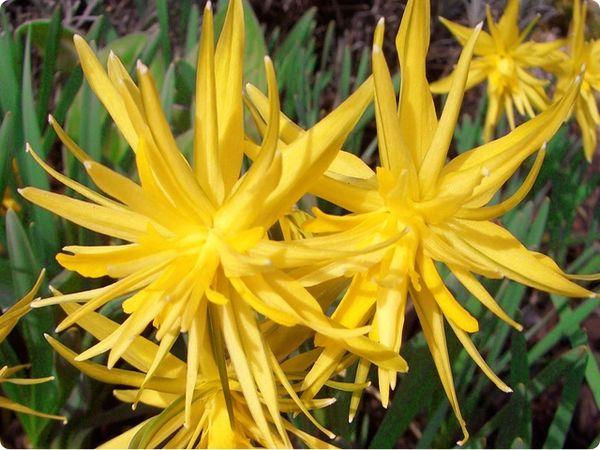
How to plant
Bulb selection
We do not always buy bulbs at exhibitions and in specialized stores, so when buying it is important to pay attention to the fact that:
- the onion was strong;
- the bottom and neck are dry;
- scales - smooth, pure brown or golden;
- there was no mold, stains, or other damage;
- and even so that there is no suspicious smell.
Selected strong bulbs are treated with a fungicide solution.
Seat selection
Whether on a summer cottage, near your house or the entrance of a high-rise building, you will plant the bulbs of the daffodil Rip van Winkle, you will have to take into account the same:
- for abundant flowering, the sunny side is preferable, but in the direct sun the flowers fade;
- windless;
- it's not bad if there are rare shrubs nearby for symbolic shading;
- the soil should not be dense: if clayey, it would be good to add sand, peat;
- waterlogged or even waterlogged soil will simply kill the bulbs.
Rip van Winkle is often purchased for indoor cultivation.
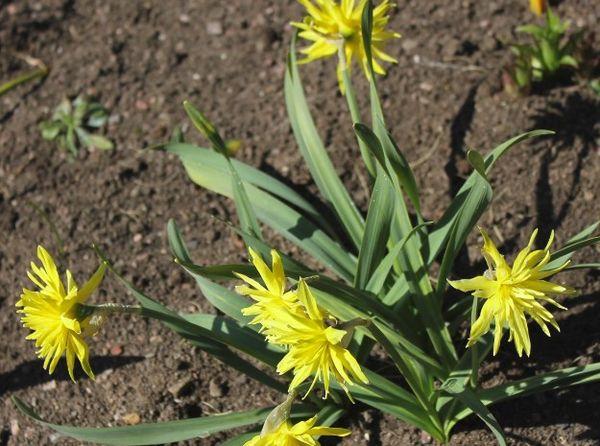
Landing dates
Many are wondering, is it better to plant daffodils in spring or autumn? Still, in the fall - it's more correct.
When planting in spring, the plant will not have enough time to take root. And this will affect the abundance of flowering and the size of the flower.
The most suitable time is from August 15 to September 15.About two months before the stable frost, daffodils will be able to settle in a new place and get stronger.
You can plant daffodils in the spring, just before planting you will have to keep the bulbs in the refrigerator for two months, otherwise they will not bloom.
How to plant
If you decide to plant in the fall, then in June you need to dig up the soil to the depth of a shovel. It is necessary to plant with a distance of 15 cm between the bushes of daffodils. The bulb is usually buried in three of its widths. Well-rotted humus or compost is added to the hole. A group of 6-8 colors makes a good impression.
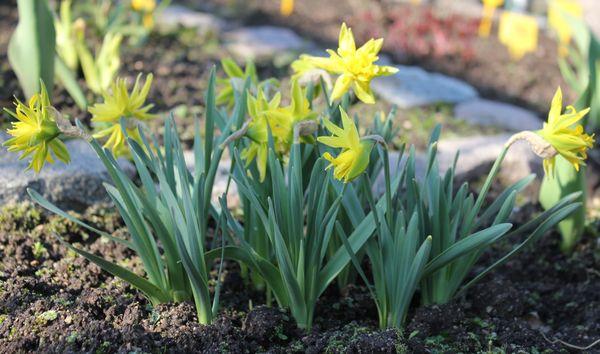
Given the frost resistance of this particular variety, it is not necessary to mulch the planted bulbs with peat.
Growing
Watering
Narcissus Rip van Winkle is a picky variety, waterlogging is only very harmful to him. Natural precipitation is usually sufficient. But in dry season, watering is necessary during flowering and about one and a half months after. From the heart - once a week, avoiding water getting on flowers and buds.
Top dressing
With the usual care of daffodils after snow melting, it is enough to feed the seedlings with complex mineral fertilizer.

For a more impressive flowering, daffodil Rip van Winkle is fed 4 times:
- for seedlings - complete mineral fertilizer;
- when peduncles appear - nitrogen and potassium;
- with full budding - again the nitrogen-phosphorus-potassium complex;
- flowering begins - potash-phosphorus fertilizers.
You cannot experiment with fresh manure, it will attract a daffodil fly and an onion hoverfly.
Mulching
Like other cultivated plants, the daffodil needs constant weeding and loosening of the soil. Mulching will greatly facilitate this task. Moreover, when loosening, bulbs and roots can be damaged. In addition, it will still keep the soil moist, that is, there will be no need for additional watering. Usually they are mulched with compost.

Disease protection
This concern is constant, because bulbs have a lot of diseases and pests. And the narcissist Rip van Winkle is no exception.
Daffodils are threatened by all sorts of rot, striping, mosaic, nematode. All these misfortunes can be fought with disinfectants. And for prevention, treat the bulbs with them before storage and planting.
Diseased plants are immediately removed so as not to infect the rest, and buried in the distance, sprinkling them with bleach. The site is disinfected with copper sulfate.
The most dangerous pests for a narcissist:
- onion hover;
- root mite;
- narcissus fly;
- slugs, bears.
They are fought with insecticides.
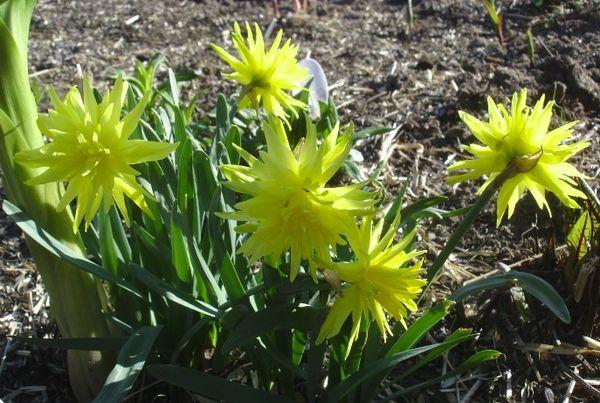
Bloom
Rip van Winkle is a terry multi-flowered daffodil from the Botanical class. When flowers bloom in a flower bed, the first impression is large dandelions, but lush balls of needle petals stop the eye, and the delicate aroma causes emotional excitement.
Flowers up to 5 cm in size stand out very much in a garden or front garden that has not yet woken up. Among the ripening white muscari, purple hyacinths and botanical tulips, they look stunning in a good way: you want to sit on a bench next to it and admire endlessly. In general, the Botanical class unites flowers no more than 20 cm tall.
Rip van Winkle blooms for 8-10 days. Ovaries should not be allowed to appear so that they do not take away the strength from the flower, therefore, the faded heads are removed.
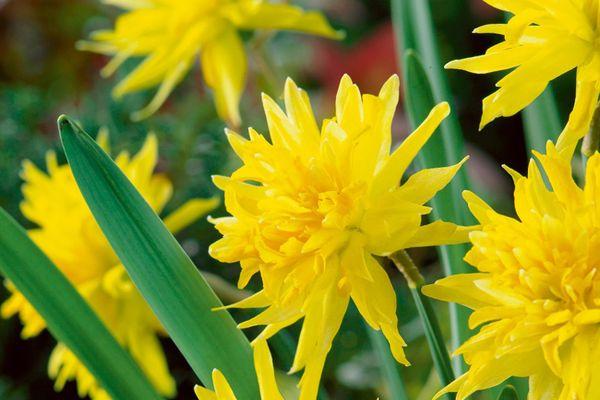
The variety pleases with full-fledged flowering for a long time, but is gradually reborn into a "wild flower". As soon as there are fewer flowering shoots, the bulbs are transferred to another place.
Leaves are not cut after flowering. The plant feeds until they die off completely.
Reproduction
Usually daffodils are propagated by babies (bulbs). There is a use case for seeds too, but this is not the case for Rip van Winkle. Artificial hybrids, if grown by seeds, are deprived of varietal characteristics.
On average, bulbs give up to 4 babies per season.They will bloom next spring. Therefore, they can be separated during transplantation and formed into an independent group.
